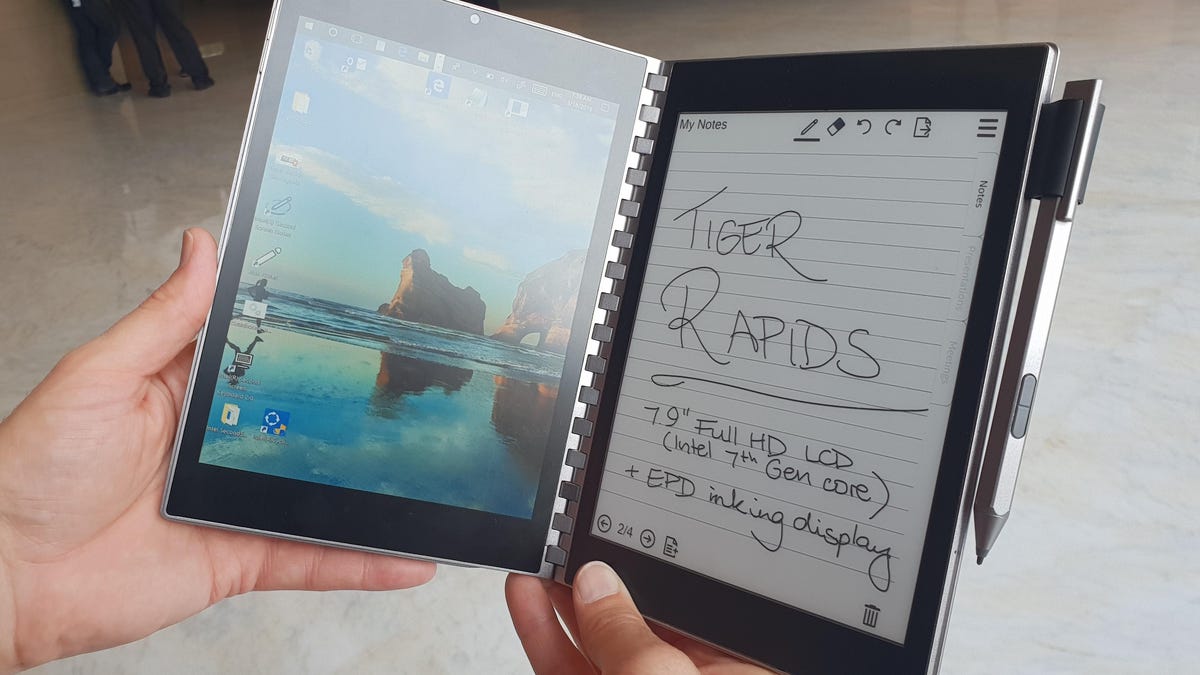Intel's Tiger Rapids is the two-screen notebook I've always wanted
It's a concept for Intel, but the company hinted that one of its manufacturing partners is set to release something very similar by the end of the year.

Intel's Tiger Rapids prototype features a Full HD LCD display on one side and an inkable electronic paper display on the other.
Razer's three-screen Project Valerie was a pipe dream; Intel's two-screen notebook prototypes may never sit on your lap, but will likely be the basis for real products you can buy in the not-so-distant future. Intel's "Tiger Rapids" prototype and other working models provide hints of what we'll see.
While the buzz at Computex 2018 was about previews of two-screen models like Asus ' Project Precog and the update to Lenovo's Yoga Book, it looks like Intel is driving a lot of the designs behind the scenes.
We got hands on with Intel's Tiger Rapids prototype, and it feels like a notebook from the future.
First reported by PCWorld, the Tiger Rapids design is the size of a regular Moleskine notebook and about as thick. Intel says it wanted Tiger Rapids to recreate the function of a paper notebook in a "highly mobile device".
That means a 7.9-inch Full HD LCD display on the left and an electronic paper display (EPD) on the right for inking. In the middle, a hinge lets you fold it up flat like a notebook to create an ultra-thin slate. Inside, Tiger Rapids runs a seventh-generation Intel Core processor and has an SSD, Wi-Fi antenna and memory. It charges via the single USB-C port, and Intel says that the battery has lasted for 13 to 15 hours in its testing.
The displays adapt to the device's orientation, with the EPD able to be used as a keyboard.
But while the two displays look like discrete elements -- a kind of old school meets new school, pen vs digital -- the two displays also work together.
You can take notes and on the "paper" display and then email them or open them on the LCD screen through OneNote. The displays also adapt to the device orientation -- in laptop mode, you can use the LCD display as a traditional screen and the EPD as a keyboard (while still keeping an area to jot notes, which are then converted to text).
The typing was a little clunky, and on such a small display it's hard to get accuracy, but it's a good proof of concept.
It'd be terrific if the company could work pressure sensitivity into that screen for sketching, but the EPD feels natural for writing (Intel says it did rounds and rounds of internal testing to get the screen coating right, and using the pen has an almost scratchy, pencil-to-paper feel). When we tested it out at Computex, it felt like a natural writing experience and much more realistic than other stylus-and-screen combos.
Tiger Rapids won't be making its way to stores -- Intel says its presence at Computex is intended as a reference design to show manufacturing partners what's possible. But in our briefing, Intel did reveal that one of its partners is looking at a very similar concept and has plans to release by the end of the year.
So you could be writing out Christmas e-cards by hand this year.
First published June 6, 10:16 a.m. PT.
Update, June 7, 12:50 a.m.: Adds hands-on impressions and additional details about features.
Computex 2018: Check out CNET's full coverage from Asia's biggest tech show.



